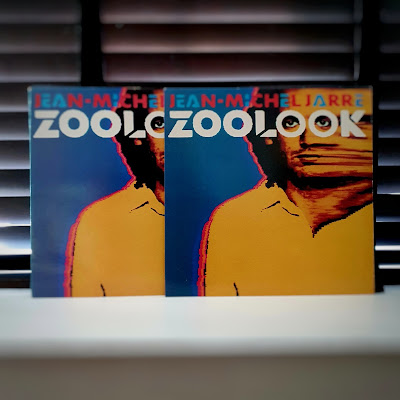Yet, the album Jarre delivered that year was so far removed from "Revolutions" that I was left disappointed. That's not to say "Waiting for Cousteau" is a bad album; it is more that it was a change of direction that left many of us behind.
Here I am playing an LP I bought in 2015 from eBay, but on the day this album was released, I was firmly committed to CD. As you can see form the picture, I also have a couple of promo posters for the album as I just happened to be walking out of an HMV store as one of the assistants was tearing down a giant window display. I decided to try my luck and asked if I could have a poster. The shop assistant looked at me uncertainly as if he was trying to think of reasons why he couldn't give me one. Having failed to find sufficient rationale to deny my request he searched through the jumble of torn paper and ripped album sleeves and pulled out two of the least mutilated posters. Whilst both posters have a tear in the bottom left hand corner, I managed to disguise the damage sufficiently for them to adorn my bedroom walls during my youth.
The lead single and main theme from this album is a track called "Calypso". As I'm not a massive fan of steel band or Caribbean music, this song has never been to my taste. At eight and a half minutes in length, it is also too long. The single edit comes in at under three minutes and is probably the version I find most palatable.
We find ourselves on more familiar ground with the next track "Calypso Part 2" which sounds like it could have been taken directly from "Revolutions". After around four minutes we enter a second movement that sees the steel band returning to compliment the churning synth arpeggios and haunting melodies. For me, this second movement is the standout piece on the record.
Whilst this is one of the first Jean Michel Jarre albums where the sleeve doesn't tell us which instruments were played, it is clear he used his Roland D-550 for "Calypso, Part 3 (Fin Du Siècle)". I'm not too keen on the first few minutes of this track but it comes alive after about four minutes and proves to be quite entertaining from that point on.
The biggest disappointment of this album has always been the title track. The fist time I played this album I was expecting this to be one of Jarre's extended symphonic pieces like "Second Rendez-Vous" or "Magnetic Fields Part I". As the music played I began to ask myself, "When is something going to happen?" After a few minutes I was bored enough to use the "seek" function on my shiny new CD player. I was pretty incredulous when I realised this forty minute track was nothing but an ambient dirge. I had been robbed! This wasn't music, it was just a drone with a sprinkling of piano here and there.
The LP and cassette includes a 22 minute version of this cut with the 47 minute version reserved for the CD. I have a memory of advertising for this album mentioning the CD had 24 minutes of extra music and I ruefully reflected that I'd rather have the LP. Today, I still don't listen to "Waiting for Cousteau" and hearing it on this record is the first time I have ever sat through the whole piece (albeit the 22 minute version). I admire this track more than the petulant teenager who heard it back in 1990, but I can't pretend this is one of Jarre's best efforts. 2/5








